小学教资面试试讲模板——英语-(4)
小学英语试讲稿模板、小学英语教师招聘面试试讲稿模板
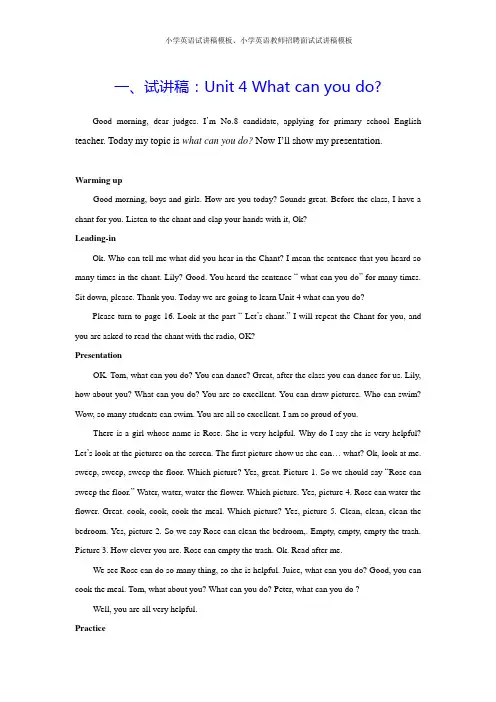
一、试讲稿:Unit 4 What can you do?Good morning, dear judges. I’m No.8 candidate, applying for primary school English teacher. Today my topic is what can you do? Now I’ll show my presentation.Warming upGood morning, boys and girls. How are you today? Sounds great. Before the class, I have a chant for you. Listen to the chant and clap your hands with it, Ok?Leading-inOk. Who can tell me what did you hear in the Chant? I mean the sentence that you heard so many times in the chant. Lily? Good. You heard the sentence “ what can you do” for many times. Sit down, please. Thank you. Today we are going to learn Unit 4 what can you do?Please turn to page 16. Look at the part “ Let’s chant.” I will repeat the Chant for you, and you are asked to read the chant with the radio, OK?PresentationOK. Tom, what can you do? You can dance? Great, after the class you can dance for us. Lily, how about you? What can you do? You are so excellent. You can draw pictures. Who can swim? Wow, so many students can swim. You are all so excellent. I am so proud of you.There is a girl whose name is Rose. She is very helpful. Why do I say she is very helpful? Let’s look at the pictures on the screen. The first picture show us she can… what? Ok, look at me. sweep, sweep, sweep the floor. Which picture? Yes, great. Picture 1. So we should say “Rose can sweep the floor.” Water, water, water the flower. Which picture. Yes, picture 4. Rose can water the flower. Great. cook, cook, cook the meal. Which picture? Yes, picture 5. Clean, clean, clean the bedroom. Yes, picture 2. So we say Rose can clean the bedroom,. Empty, empty, empty the trash. Picture 3. How clever you are. Rose can empty the trash. Ok. Read after me.We see Rose can do so many thing, so she is helpful. Juice, what can you do? Good, you can cook the meal. Tom, what about you? What can you do? Peter, what can you do ?Well, you are all very helpful.PracticeNow, I will divide you into pairs. Student A does some behaviors, and student B guess what can he/ she do? You should use the phrases we learn today, clear? Ok , five minutes.Now I will invite two groups to come here to play a game with me. I have twenty cards. On each card, there is a phrase. A student will do the behavior according to the card, and ask “ what can I do?” While the other student will guess what he/ she is doing, and answer: “You can…” The student who finish the guessing game first will get a present. Clear? Ok, volunteers? Sue and Jim. Apple and William. Come here, please. Let’s begin.Well done, boys and girls. So the winner is Sue and Jim. Congratulations. We also have some little presents for Apple and William. Congratulations.ConsolidationNow turn to page 23. Supposing you are a reporter, and you should ask your friends a question“ what can you do?” You have ten minutes to finish the table. Let’s begin. Winey, would you like to share your report? Thank you, sit down, please.SummaryWe have only 5 minutes left. We have to stop here. Today we have learnt many phrases and I found that you are all very helpful. Since you are helpful, I wish you can help your parents at home with the housework. Will you?HomeworkOkay, time is up. here is the homework for you: make a list of “ what can I do.” Then share it with us next class. Have a nice day. See you!That’s my presentation. Thank you.二、试讲稿人教版英语三年级下册Unit 5 Where is myruler?PART AGood morning, teachers! I am No. One candidate, today I am applying for the primary school English teacher. My topic is “Where is my ruler”. Now let’s begin my class.Good morning, everyone, nice to see you! How are you? I am great! Thank you!Look, here is a box. There are many things in it. What’s this? Mary, yes, this is a ruler. And what’s this? Peter, yes, this is a book. And what’s this? Tom, yes, this is a crayon. So, what’s this? Cherry, yes, this is a pencil. Now, look! What’s this? Yes, it is a bike and it is a toy bike. And what’s this? Yes, it’s a bus. We take bus everyday. And how about this? Good, it’s a taxi. Some stude nts may take taxi to go to school. And what’s this? Who knows? Right, it’s a jeep. And I have more things. Look, what’s this? We use it when it rains. How to speak it in English? Good, it’s an umbrella. Read after me, umbrella, umbrella. And what’s this? It’s a violin. And how about this? It’s a vest. We wear it in hot summer. And look there, what’s that? Yes, that’s window. And the wind blows through the window. Right? Good!And please close your eyes, I will hide them and you will guess where it is. Ok? Now, please open your eyes. Where is my ruler? In the desk? No! On the chair? No! In the book? Yes, it is in the book. Very good! You did a good job! Now, I will divide you into several groups, one student will hide the things and the others will guess. I will give you five minutes to play this game.Now, let’s listen to the tape and think about two questions: Who is that boy?/Who is that mother? Ok,finish! Who can answer my questions? Who is that boy? Sam, please tell us the answer? Do you know him? Good, he is Mike. And so we know that she is Mike’s mother. From the picture, we know that Mike’s room is untidy. And he can’t find his things, so he asks his mother. Here I want two students toperform this dialogue, one acts Mike, and the other acts Mike’s mot her? Who want to have a try? Ok,good, Linda and Peter! So if you want to find something, you can say “where is my...?”, and other people will answer you. If you find it, you can say “It’s in/on/under...”Now, everyone can find a partner and practice the d ialogue such as “Let’s practice” on page 50. And you may use the sentence patterns we have learned today. Who can perform the dialogue for us, and you should use the sentence patterns and words we have learned today: What’s this?/It’s .../Where is the/my...?/It’s in/on/under.../ruler, book, pencil, erase, bike, bus, taxi, jeep, doll, vest, umbrella, vest, violin. Ok, who want to have a try? Good, Lucy and Sam, please come here! You did a good job! Ok, let’s review what we have learned today. You should answer my questions together! Look, what’s this? Yes, it’s an umbrella, pay attention to “an”. And what’s this? It’s a vest. And how about it? Right, it’s a violin. And what’s this? Good, it’s a vest. So what’s that? Yes, it’s window and wind blows through the window. In winter, we should close the window. Ok, please close your eyes. Open your eyes. And you can guess, where is my umbrella? Who know? In the desk? No! In the bag? No! Look, it’s under the chair. Yes, it’s under the chair. Thank you! You help me find the umbrella.Now, let’s think about what we have learned today. Who can tell us? Tom, please! Fantastic, today we have learned some stentence patterns:What’s this?/It’s .../Where is the/my...?/It’s in/on/under.../ and some new words: ruler, book, pencil, erase, bike, bus, taxi, jeep, doll, vest, umbrella, vest, violin and so on. And who want to say other things? Ok, Mary, yes, we have also learned three new letters: U,V,W. Good, sit down, please! And we should keep our room clean and tidy because it is hard for us to find the things we want if the room is untidy.So, today, after school, you should listen to the tape and perform it out for your parents and then tell your parents what you have learned from this lesson.O k, today’s class is over, see you!That’s all for my class, thank for your attention!三、PresentationGood morning, dear judges. I am NO.4 candidate applying for middle school English teacher. It is really an honor for me to be interviewed here. Today, my title is: What’s the matter? Now, I am going to begin my class.Hello, good morning ! How are you today? ( I’m fine.) okay, that’s nice. I hope all of you can keep this good feeling the whole day. All right? Now, before our today’s lesson, I want to ask you to do a favor for Doctor. Wu.Firstly, please look at the PPT. Doctor. Wu is a surgeon at Tongji Hospital. He is going to America for further study. But he doesn’t know how to describe our body in English. Is there anyone who can teach him? Now, I will choose two students to be Doctor Wu’s English teacher. Any volunteers? Okay, thanks, Jason and Rose. Firstly, Jason, please stand up! Now, please look at me and tell us the English words of what I point at. ( Jason: head, face, ear……) great! Thank you. Sit down, please. Then, Rose. ( Rose: leg, foot, hand….) well done!but please pay attention to the pronunciation of “hand”, read after me. Okay, I think both of you will be a great teacher if you can study harder. After that, please everybody turns to page 7 of our textbook and look at part 1a. you must have been very familiar to these words, so let’s do a review. Please read after me and pay attention to your pronunciation.(……..)Great! Do you want to play a word puzzle? (yes, yes……) okay, please finish this word puzzle on the PPT as soon as possible. Finished? Do you have any question about this? How about I choosing one of you to tell us the answer? So, Mary, can you do that? Nice, please stand up! (…….) Now, let’s learn something new. If there are something wrong with our body, how can we describe this situation? For example, when your body temperature is over 39 C, we will say “ganmao” in Chinese. But, do you know how to say in English? Okay, don’t worry. Today, I will be with you to learn that.Firstly, let’s see the picture on Page. 7. There is a very important sentence we have to learn. What’s the matter? “matter” means “problem” . Thatis to say, it equals to “what’s the problem?” Take notes! In Chinese, “有什么事情吗?出了什么麻烦吗?”If you find your mother in a bad health, you may ask her “ what’s the matter?” right? So, this sentence is very useful in our daily life. Please remember that and use it when necessary. Okay, then, we will learn some words, please look at PPT. We have fever, cold, sore throat, sore back, stomachache, toothach e… Now, please read after me. Do you know their meaning? I have pasted their explanations on PPT, can you guess and match them?(…….)Okay, we have already got their definition. If you don’t feel good about your throat, you can say “ I have a sore throat”.So, we have to add “ have”. Please look at Part 1c. there is a pair work exercise for you. Let’s do that!Firstly, please see the example……I will divide all of you into four groups. After a short discussion, each group has to choose two members to stand up about your conversation. Okay? Now, please group 1….Group 2… group 3… group 4…Well done! Please applause for yourself. Then, let’s finish Part. 2a. Finished? Great, till now, we have done some reading, writing and speaking practice. How about doing some listening exercises? Okay, please turn to page. 8 and look at Part. 2b. I will let you listen to the tape twice. Please listen to that carefully.(…….) Jack, can you tell me your answer of question.1? Thank you. Sit down, please. Ben, can you tell me your answer of question.2? Good! Sit down, please. Kate, can you tell me your answer of question.3? Is that right? Think about that for a while. Actually, the right answer is…… Sit down, please. Lisa, can you tell me your answer of question.4? Excellet. Sit down, please.In a word, the answer of these four questions are:……..Do you any questions about this listening exercise? Considering you have no questions, let’s move on. We will see the grammar focus. I will give you two minutes to see this. After that, I will choose two of you to make a summary of the grammarfocus! So, let’s move!....(…….)Okay, that’s enough. Now, please draw your attention to the PPT. I have made a outlook of our lesson. Please follow me to review today’s lesson.(…….)Do you have any question about our today’s lesson?Great, let’s call it a day. Have a rest!That’s my presentation, thanks for your listening!。
小学英语教师面试试讲_教案模板
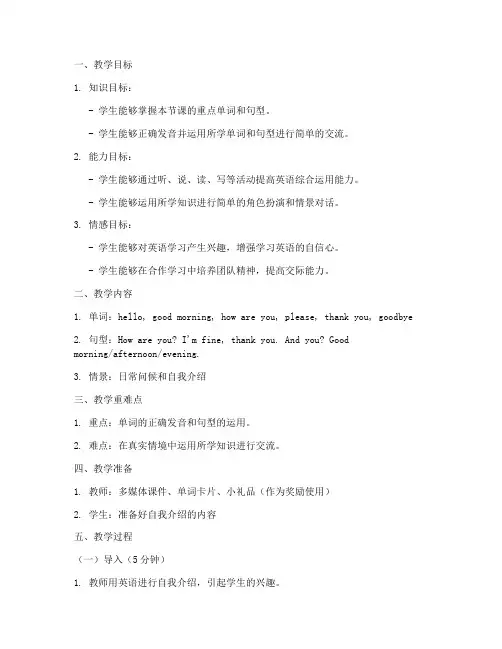
一、教学目标1. 知识目标:- 学生能够掌握本节课的重点单词和句型。
- 学生能够正确发音并运用所学单词和句型进行简单的交流。
2. 能力目标:- 学生能够通过听、说、读、写等活动提高英语综合运用能力。
- 学生能够运用所学知识进行简单的角色扮演和情景对话。
3. 情感目标:- 学生能够对英语学习产生兴趣,增强学习英语的自信心。
- 学生能够在合作学习中培养团队精神,提高交际能力。
二、教学内容1. 单词:hello, good morning, how are you, please, thank you, goodbye2. 句型:How are you? I'm fine, thank you. And you? Goodmorning/afternoon/evening.3. 情景:日常问候和自我介绍三、教学重难点1. 重点:单词的正确发音和句型的运用。
2. 难点:在真实情境中运用所学知识进行交流。
四、教学准备1. 教师:多媒体课件、单词卡片、小礼品(作为奖励使用)2. 学生:准备好自我介绍的内容五、教学过程(一)导入(5分钟)1. 教师用英语进行自我介绍,引起学生的兴趣。
2. 学生模仿教师的自我介绍,教师给予鼓励和指导。
(二)新课讲授(15分钟)1. 展示单词卡片,引导学生说出单词的正确发音。
2. 通过游戏或歌曲等形式,让学生熟悉单词和句型。
3. 教师带领学生进行句型练习,如:- How are you? I'm fine, thank you. And you?- Good morning/afternoon/evening.4. 分组活动,让学生运用所学知识进行角色扮演。
(三)巩固练习(10分钟)1. 教师设置情景,让学生运用所学知识进行对话。
2. 学生自由组合,进行情景对话练习。
3. 教师巡视指导,纠正发音和语法错误。
(四)总结与拓展(5分钟)1. 教师总结本节课所学内容,强调重点单词和句型。
小学英语面试试讲通用版
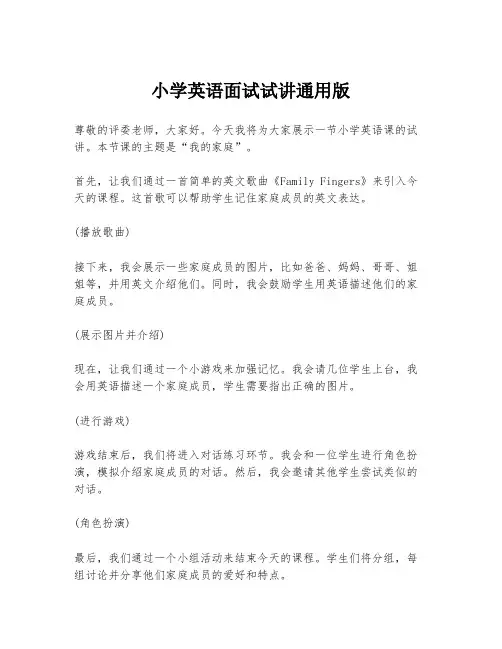
小学英语面试试讲通用版
尊敬的评委老师,大家好。
今天我将为大家展示一节小学英语课的试讲。
本节课的主题是“我的家庭”。
首先,让我们通过一首简单的英文歌曲《Family Fingers》来引入今天的课程。
这首歌可以帮助学生记住家庭成员的英文表达。
(播放歌曲)
接下来,我会展示一些家庭成员的图片,比如爸爸、妈妈、哥哥、姐姐等,并用英文介绍他们。
同时,我会鼓励学生用英语描述他们的家庭成员。
(展示图片并介绍)
现在,让我们通过一个小游戏来加强记忆。
我会请几位学生上台,我会用英语描述一个家庭成员,学生需要指出正确的图片。
(进行游戏)
游戏结束后,我们将进入对话练习环节。
我会和一位学生进行角色扮演,模拟介绍家庭成员的对话。
然后,我会邀请其他学生尝试类似的对话。
(角色扮演)
最后,我们通过一个小组活动来结束今天的课程。
学生们将分组,每组讨论并分享他们家庭成员的爱好和特点。
(小组活动)
通过今天的学习,我希望学生们能够掌握家庭成员的基本英文表达,并能够在日常生活中灵活运用。
谢谢大家的聆听,期待与学生们在课堂上的互动。
(结束语)。
小学教资英语面试教案万能模板
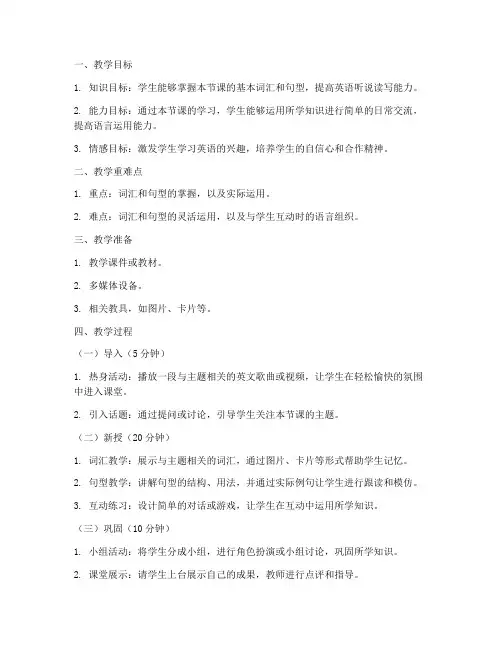
一、教学目标1. 知识目标:学生能够掌握本节课的基本词汇和句型,提高英语听说读写能力。
2. 能力目标:通过本节课的学习,学生能够运用所学知识进行简单的日常交流,提高语言运用能力。
3. 情感目标:激发学生学习英语的兴趣,培养学生的自信心和合作精神。
二、教学重难点1. 重点:词汇和句型的掌握,以及实际运用。
2. 难点:词汇和句型的灵活运用,以及与学生互动时的语言组织。
三、教学准备1. 教学课件或教材。
2. 多媒体设备。
3. 相关教具,如图片、卡片等。
四、教学过程(一)导入(5分钟)1. 热身活动:播放一段与主题相关的英文歌曲或视频,让学生在轻松愉快的氛围中进入课堂。
2. 引入话题:通过提问或讨论,引导学生关注本节课的主题。
(二)新授(20分钟)1. 词汇教学:展示与主题相关的词汇,通过图片、卡片等形式帮助学生记忆。
2. 句型教学:讲解句型的结构、用法,并通过实际例句让学生进行跟读和模仿。
3. 互动练习:设计简单的对话或游戏,让学生在互动中运用所学知识。
(三)巩固(10分钟)1. 小组活动:将学生分成小组,进行角色扮演或小组讨论,巩固所学知识。
2. 课堂展示:请学生上台展示自己的成果,教师进行点评和指导。
(四)总结(5分钟)1. 回顾:对本节课所学内容进行回顾,强调重点和难点。
2. 作业布置:布置课后作业,巩固所学知识。
五、板书设计1. 主题词汇2. 主题句型3. 重点单词及用法六、教学反思1. 教学过程中,关注学生的个体差异,因材施教。
2. 创设轻松愉快的课堂氛围,激发学生学习英语的兴趣。
3. 注重学生的语言实际运用能力,提高学生的英语素养。
七、教学评价1. 课堂参与度:观察学生在课堂上的表现,评价其参与度和积极性。
2. 知识掌握情况:通过课堂提问、作业完成情况等,评价学生对知识的掌握程度。
3. 语言运用能力:通过角色扮演、小组讨论等活动,评价学生的语言实际运用能力。
八、教学建议1. 注重学生的听说读写能力培养,全面发展。
小学英语试讲稿(全英版)(精选五篇)
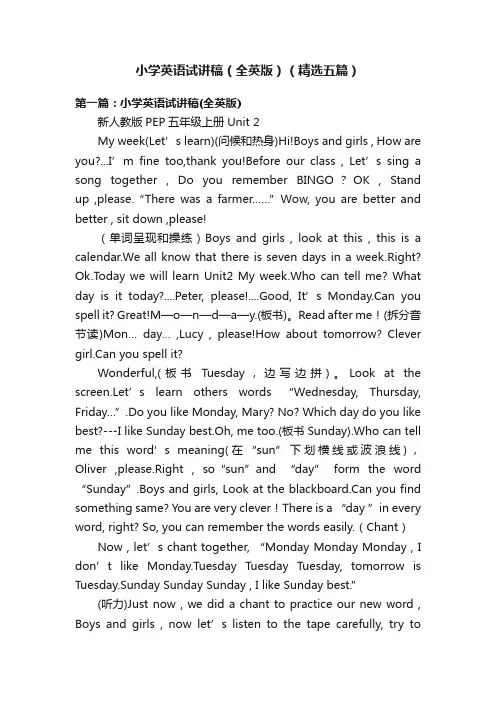
小学英语试讲稿(全英版)(精选五篇)第一篇:小学英语试讲稿(全英版)新人教版PEP五年级上册Unit 2My week(Let’s learn)(问候和热身)Hi!Boys and girls , How are you?...I’m fine too,thank you!Before our class , Let’s sing a song together , Do you remember BINGO?OK , Stand up ,please.“There was a farmer……”Wow, you are better and better , sit down ,please!(单词呈现和操练)Boys and girls , look at this , this is a calendar.We all know that there is seven days in a week.Right? Ok.T oday we will learn Unit2 My week.Who can tell me? What day is it today?....Peter, please!....Good, It’s Monday.Can you spell it? Great!M—o—n—d—a—y.(板书)。
Read after me!(拆分音节读)Mon… day… ,Lucy , please!How about tomorrow? Clever girl.Can you spell it?Wonderful,(板书Tuesday,边写边拼)。
Look at the screen.Let’s learn others words “Wednesday, Thursday, Friday…”.Do you like Monday, Mary? No? Which day do you like best?---I like Sunday best.Oh, me too.(板书Sunday).Who can tell me this word’s meaning(在“sun”下划横线或波浪线),Oliver ,please.Right , so“sun”and “day” form the word “Sunday”.Boys and girls, Look at the blackboard.Can you find something same? You are very clever!There is a “day ”in every word, right? So, you can remember the words easily.(Chant)Now , let’s chant together, “Monday Monday Mond ay , I don’t like Monday.Tuesday Tuesday Tuesday, tomorrow is Tuesday.Sunday Sunday Sunday , I like Sunday best.”(听力)Just now , we did a chant to practice our new word , Boys and girls , now let’s listen to the tape carefully, try tounderstand the meaning , and then answer my question.The first one “What’s this in the picture?”… Second :“What does Wu yifan have on Mondays ?” Now go for it!Time is over.Any volunteers? Ok, John, Please.This is a schedule.Right or wrong?? Good , the second one.Peter , please.Excellent!He has Chinese, English, maths and music.(呈现和操练句子)Now, let’s focus on this sentence “What do you have on Mondays?”(板书句子).What’s the Chinese meaning? Lily, try to translate it.…Excellent!And answer the question according this schedule.… Great!“I have Chinese, English, maths and music.” Now, I ask you questions, and you answer according the schedule.For example:“ What do you have on Tuesdays?----I have ……”.“What does Peter have on Fridays?---He has……”.“What do they have on Fridays?---They have……”(操练巩固)Now, practice our key sentences with your partner.After 3 minutes I want some of you to share with us.Let’s begin!Who want to try? Daniel and Edward.How fluently you speak!Thank you!(再选一组,再表扬)Now, let’s do the group work, four students make a group, I want you can make a new schedule in your group.And then, make dialogues with your group members according your new schedules.(抽查学生)Which group want to try ,wow, so many groups!Well, you four please.Your performance is so interesting!Give me five.Any grou ps? Ok, your group.Don’t be shy, just have a try!Your pronunciation is perfect!Just now, All of you have done a good job.I’m so proud of you.(小结)Now,let’s have a summary.Who can tell me what we have learned today? How about the last boy? Yes , we learn these new words about the weekdays ,and these new sentences.Your summary is very perfect!Thank you!(作业)Here comes our homework.First, writethe new words three times.Second, make dialogues with your partner using what we have learned today.Our class is over , see you tomorrow!That’s all, thank you for your listening.第二篇:小学英语教师资格证试讲稿全英先进教室,然后回答两个问题,老师会说开始你的试讲就可以开始了。
小学英语教师招聘面试--试讲逐字稿模板
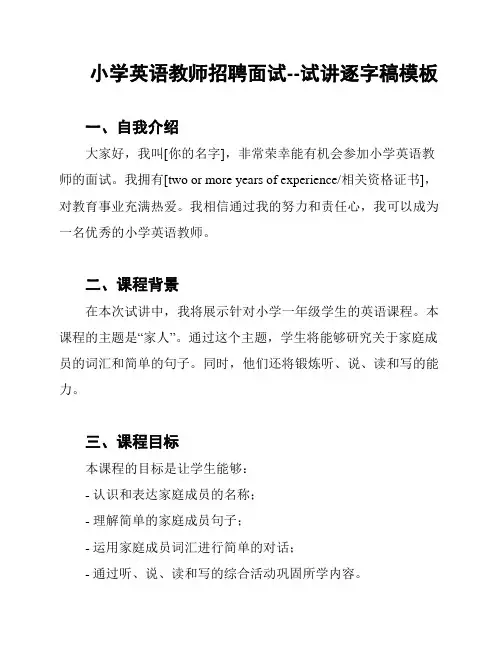
小学英语教师招聘面试--试讲逐字稿模板一、自我介绍大家好,我叫[你的名字],非常荣幸能有机会参加小学英语教师的面试。
我拥有[two or more years of experience/相关资格证书],对教育事业充满热爱。
我相信通过我的努力和责任心,我可以成为一名优秀的小学英语教师。
二、课程背景在本次试讲中,我将展示针对小学一年级学生的英语课程。
本课程的主题是“家人”。
通过这个主题,学生将能够研究关于家庭成员的词汇和简单的句子。
同时,他们还将锻炼听、说、读和写的能力。
三、课程目标本课程的目标是让学生能够:- 认识和表达家庭成员的名称;- 理解简单的家庭成员句子;- 运用家庭成员词汇进行简单的对话;- 通过听、说、读和写的综合活动巩固所学内容。
四、教学流程1. 导入/引入新课程(5分钟):- 和学生打招呼;- 介绍主题“家人”;- 引入家庭成员的词汇。
2. 教学内容展示(10分钟):- 通过图片或挂图展示各种家庭成员的名称;- 用简单句子介绍每个家庭成员。
3. 练活动(15分钟):- 师生对话练:学生们模仿老师的句子,并进行问答练;- 分组合作:学生们分组进行对话练,展示对家庭成员的理解。
4. 综合活动(10分钟):- 听力训练:播放家庭成员对话,学生们根据听到的内容选择正确的图片;- 读写练:学生们用英语写出他们自己家庭成员的名称。
5. 课堂总结(5分钟):- 总结所学内容,并对表现出色的学生进行鼓励;- 鼓励学生在家里继续练并与家人进行对话。
五、教学资源和评估- 教学资源:挂图、图片、听力材料、笔和纸;- 教学评估:观察学生的参与度、表现和对课程的理解程度。
六、潜在问题和解决方案- 学生理解能力不足:通过图片、示范和练,提供更多的语境帮助学生理解;- 学生不愿意参与:设置小组活动,创建积极、互动的研究环境,鼓励学生充分参与。
以上是本次试讲的逐字稿模板,希望能给面试官留下良好的印象。
谢谢大家!。
小学生英语面试试讲
小学生英语面试试讲尊敬的评委老师,各位同学,大家好。
今天我要进行的是一节关于小学生英语面试试讲的课程。
英语作为一门国际语言,对于我们小学生来说,学习英语不仅能开阔视野,还能培养我们的跨文化交流能力。
下面,我将带领大家走进英语的世界,体验学习英语的乐趣。
首先,我们来学习一些基础的英语问候语。
在英语中,我们可以用"Hello" 或 "Hi" 来打招呼,用 "Good morning" 或 "Good afternoon" 来问候。
例如,当你早上见到老师时,可以说 "Good morning, teacher!" 来表示尊敬。
接下来,我们学习一些简单的自我介绍。
在英语中,我们可以用 "My name is ..." 来介绍自己的名字,用 "I am ... years old" 来说明自己的年龄,用 "I come from ..." 来表明自己的家乡。
例如:"My name is Li Ming, I am 10 years old, and I come from Beijing."此外,我们还会学习一些常用的英语词汇。
比如,颜色(color)、动物(animal)、数字(number)等。
我们可以通过图片或者实物来帮助记忆这些词汇。
例如,看到一只猫(cat),我们可以学习 "Thisis a cat." 来描述它。
在英语面试试讲中,我们还会练习一些简单的对话。
对话是语言交流的重要组成部分。
比如,我们可以练习购物时的对话:"Can I help you?" "Yes, I want to buy an apple." 这样的对话可以帮助我们更好地理解英语的实际应用。
教师招聘面试英语老师科目试讲万能模板
教师招聘面试英语老师科目试讲万能模板英语教师招聘面试试讲模板一、引言(Introduction)1. 自我介绍(Self-introduction)感谢面试官的邀请,我是XXX,来自XXX学校,非常荣幸能够参加本次面试。
我拥有XXX教育学位,并有多年的英语教学经验。
我热爱英语教育事业,愿意将自己所学和所想与学生分享,激发他们对英语学习的兴趣。
2. 试讲内容简介(Introduction of the lesson)今天我将为大家带来一节英语课程,主题是XXX,它是我们英语教学中非常重要的一个话题/文化/技能。
通过这节课,学生将能够XXX。
3. 学习目标(Learning objectives)在本节课中,学生将会XXX。
他们将能够XXX。
4. 教学方法(Teaching methods)本课采用了XXX的教学方法。
我们将运用XXX来提高学生的XXX。
二、教学过程(Teaching procedures)1. Warm-up(热身活动)这是课程开始前的热身活动,目的是吸引学生的注意力,引起学生的兴趣。
比如,我会使用一个有趣的英语谜语/歌曲/游戏,与学生互动,让他们积极参与。
2. Presentation(呈现)本环节是向学生介绍和展示新知识的阶段。
我会以一个有趣的故事/视频/图片为起点,引入新的知识点。
通过情境教学,使学生能够轻松理解新知识。
3. Practice(练习)在这一环节,我会设计一些练习活动,旨在帮助学生巩固所学知识,并提高他们的运用能力。
我会使用角色扮演/小组讨论/练习对话等多种形式,让学生在实践中学习和运用语言。
4. Production(产出)在这个环节,学生将有机会运用所学知识进行创造性的表达。
我会设计一些任务,要求学生运用课上学到的知识,完成一些任务或者展示自己的创意。
这将激发学生的学习兴趣和积极性。
5. Extension(拓展)为了进一步提高学生的学习能力和能够应用知识,我会在这个环节中设置一些扩展活动。
(完整版)试讲模式之小学英语试讲模板
(完整版)试讲模式之小学英语试讲模板
一、教学目标
通过本节课的教学,使学生能够:
- 掌握单词和短语:...
- 学会运用句型:...
- 培养语言表达和沟通能力
二、教学重点
- 学会单词和短语的正确发音和用法
- 理解并运用句型进行简单的对话
三、教学难点
- 学会自己主动运用所学内容进行表达
四、教学准备
- 教学课件
- 单词和短语卡片
- 音频播放设备
五、教学过程
1. 创设情境:...
2. 引入新知识:...
3. 单词和短语讲解和练:...
4. 句型讲解和练:...
5. 模仿对话练:...
6. 作业布置:...
六、教学方式
- 情境导入
- 师生对话
- 小组讨论
- 师生互动
七、教学评价
- 通过听力练和问答活动检查学生的听说能力
- 通过课堂练和小组讨论检查学生的理解和表达能力- 通过作业批改和口头回答问题检查学生的研究效果
八、教学反思
- 检查学生对新知识的掌握情况
- 改进教学方法和策略
- 总结教学经验,为下一次教学做准备
以上是小学英语试讲模板的完整版。
通过按照该模板的步骤进行教学,可以帮助学生掌握相关单词,短语和句型,并提高他们的语言表达和沟通能力。
同时,对于教师来说,也需要在教学反思环节不断改进教学方法和策略,以提升教学效果。
小学英语全英文试讲 小学英语说课万能模板
小学英语全英文试讲小学英语说课万能模板Good morning everyone. My name is [Your Name], and I am a teacher at [Your School]. Today, I am here to share my teaching plan for a primary school English lesson. I believe that through this lesson, students will not only gain language skills but also develop their cultural awareness. Before we start, please feel free to ask any questions at any time.For today's lesson, my teaching goal is to help students understand and use basic English vocabulary related to daily life. I have designed a variety of activities to stimulate students' interest in learning English. We will focus on the following key points:To help students master basic English vocabulary through interactive games and activities;To enhance students' language expression ability through role-playing and group discussion;To improve students' reading comprehension through readingpractice and discussion.To achieve the above goals, I will use a combination of methods including direct instruction, group work, role-playing, and project-based learning. The detailed steps are as follows: Greeting students and leading a warm-up activity to activate students' prior knowledge;Presenting new vocabulary and sentence structures through pictures, gestures, and examples;Dividing students into groups and assigning them different roles to simulate real-life situations;Conducting reading exercises to improve students' reading comprehension;Summarizing the key points of the lesson and asking students to reflect on their learning.The key points of today's lesson are: 1) mastering basic English vocabulary; 2) understanding and using sentence structureseffectively; 3) enhancing language expression ability through role-playing activities. The难点在于: 1) pronouncing English words correctly; 2) using English sentences appropriately in different contexts. To address these challenges, I will provide clear examples, use visual aids, and provide additional practice opportunities.At the end of the lesson, I will give students a short assessment to check their understanding of the vocabulary and sentence structures. I will use a combination of methods including quizzes, role-playing activities, and observation to evaluate students' performance. After the assessment, I will provide individual feedback to help students identify their strengths and weaknesses and suggest ways to improve their language skills.Finally, I will assign some homework to help students review and consolidate their learning. The homework will include reading and reciting English sentences, role-playing with family members, and observing real-life objects in English. Inaddition, I will suggest that students continue to read English materials and watch English movies to improve their language skills outside of class.课程背景:本节课旨在引导学生学习基础英语句型,通过生动的场景和互动的对话,提升学生在日常生活中使用英语进行交流的能力。
- 1、下载文档前请自行甄别文档内容的完整性,平台不提供额外的编辑、内容补充、找答案等附加服务。
- 2、"仅部分预览"的文档,不可在线预览部分如存在完整性等问题,可反馈申请退款(可完整预览的文档不适用该条件!)。
- 3、如文档侵犯您的权益,请联系客服反馈,我们会尽快为您处理(人工客服工作时间:9:00-18:30)。
Unit 4 We love animals A Let`s learn教学设计
无板书设计、作业环节
一、教学目标
1.知识目标
学生能听懂、会说动物单词 monkey dog duck panda cat rabbit;
2.技能目标
学生能听懂课堂指令并做出相应的反应;
3.情感目标
(1)以活动为途径,渗透任务型教学,让学生在玩中学,学中玩,寓教于乐;(2)通过小组竞赛和激励性评价,让学生会与人沟通合作形成良好的语言表达能力。
二、教学重点、难点
1.教学重点
(1)能听懂、会说动物单词。
(2)学生能听懂课堂指令并做出相应的反应。
2.教学难点
(1)Canada, the United kingdom America的发音。
(2)能用英语进行介绍小动物和自己玩具。
三、教学准备
1.制作教学辅助课件
2.制作一些小动物的头饰
3.准备动物的词卡和图片
4.学生准备玩具小动物。
四、教学过程
1.Greetings:
利用 How are you? 歌曲和学生唱着问候,调动学生的学习积极性.
2.Warm-up:
Touch your nose. Touch your eye. Touch your ear. Touch your mouth. Touch your head. Touch your arm. Touch your hand. Touch your tail. 玩触摸身体部分的游戏,让学生缓解了紧张的情绪,同时对描述身体部分的单词进行了适当的复习,为下一教学环节作了铺垫。
3.Presentation:
1. T: Oh, sorry. we have no tails. But animals have tails. Let's go to the zoo. Come on boys and girls. 1 2 3 Go, go, go, go. The animals in the zoo are having a New Year's Party today. They are all very happy. Now the band is coming. Can you tell me who they are in the band?(同学们,大家看,今天动物园里的动物们正在开一个新年晚会,他们都高兴极了,现在,乐队走过来了,你们看到他们都是谁吗?)课件的形式出现,让学生进行回答。
2. 排在乐队最前面的是谁?T: Who is the first? 让学生回忆。
引出单词rabbit. 让学生听,然后让学生模仿,并试着说出这个单词中含有那些你听到的字母,练习了学生的模仿能力,单词的认读能力和拼读能力。
Who is the second? 教师可以描述一下 It likes having fish. Who is it? 引出单词 cat。
由于这个单词比较简单,因此找学生教,并试着说出这个单词中含有那些你听到的字母,练习了学生的单词的认读能力和拼读能力,调动学生的学习兴趣和积极性。
Who is the third? 教师描述 Its eyes are black and its body is white. Who is it? 引出单词 panda 领读三遍让学生齐读,小组读,并对各个小组进行评价,激励他们的学习积极性。
Who is the fourth? 课件出示小鸭子的脚印,让学生猜出第四个小动物是谁?引出单词 duck. 听音学单词,让学生学习正确的语音。
Who is the fifth? And who is the sixth? 课件出示小狗和小猴的尾巴,让学生猜出他们的主人是谁?引出单词 dog monkey. 教师领读,让学生领读,最后拼读。
在讲完了六个单词后,让学生看图片和单词,听音跟读,练习正确的语音,对单词又有了更进一步的了解,并让学生总结单词 cat panda rabbit 这三个词中“a”的读音,渗透了英语字母的读音规则。
4.Practice
T: Who has a short tail?
S: A rabbit /duck /panda
T: Who has a long tail?
S: A cat /monkey /dog
这个教学环节是一个发散思维环节,课件提供了六个动物的身体部位,分别是短尾巴和长尾巴,让学生根据这六条尾巴来说动物,达到复习动物单词的目的。
Activities 1:
T: Animals are lovely. I love animals. Do you like them?
S: Yes.
T: Now, choose your animal friends.
S: A dog, rabbit /duck /monkey /cat /panda
T: Now, you are all animals. Introduce yourself “Hello. I'm dog. How are you? ...”
这是一个操练口语的环节。
教师制作了一些动物的头饰,让学生选择一个自己喜欢的动物朋友,在小组里扮演这个小动物和其他小动物进行日常英语会话,练习了英语的表达能力,并告诉学生,动物是人类的朋友,让学生爱护动物,保护动物,和动物交朋友。
在这个环节中学生愿意开口练习。
Activities 2:
T: I have some animals. What do you have?
S: I have a dog /cat /rabbit /....
T: Great. Can you act like a dog /cat /rabbit /....
In your groups introduce your toy and act them.
在这个环节中,我让学生把自己带来的玩具,介绍给自己的小伙伴,并表演出来,让学生学会和小伙伴一起分享自己的东西,并增加了学习的趣味性。
教师要即时的评价和过程性评价的结合,在本课的最后来个终结性的评价,学生在学习的过程中始终是评价的主体,体现了以学生为主体的课改精神,同时,学生的学习积极性也得到了提高。
T: Animals are good friends. But sometimes be careful. Why? Let's discuss next class.
在课的最后给学生留下一个悬念,并让学生对课堂有中依依不舍的感觉。
五、板书设计。
